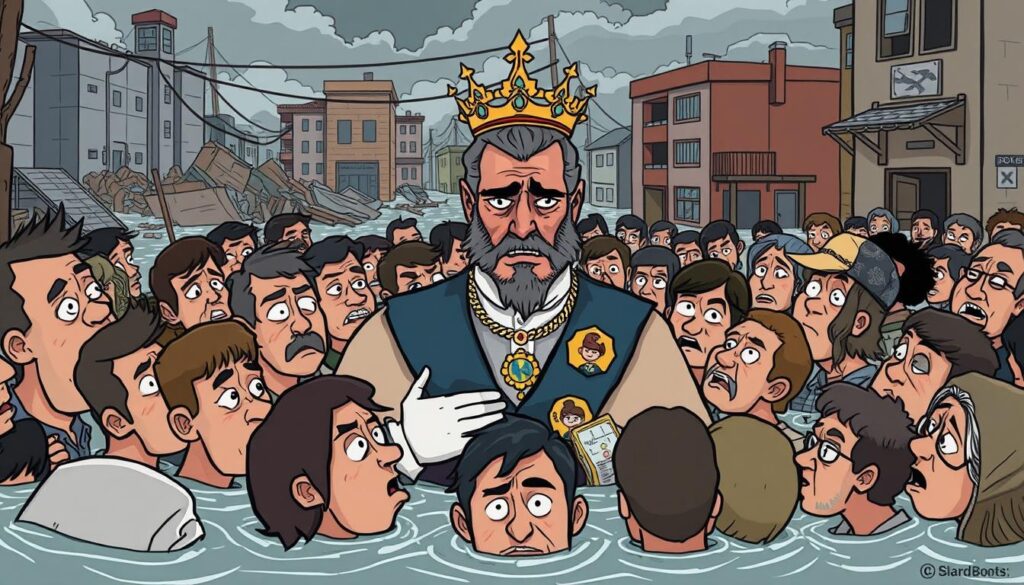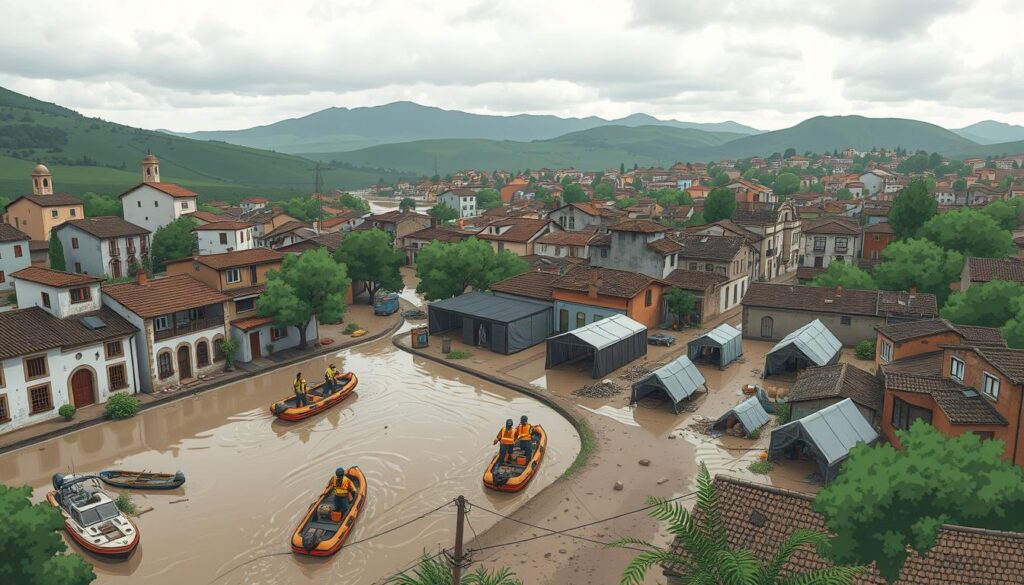At least 205 people have lost their lives in the devastating flash floods in eastern Spain. This is one of the deadliest weather events in Spanish history. The floods, caused by climate change, have destroyed thousands of homes and left many without water for days.
The Spanish government is working hard to recover from this disaster. They have sent thousands of soldiers, police, and gendarmes to help. Prime Minister Pedro Sánchez and the royal family have also visited the affected areas. They faced anger from the public for what they saw as a slow response.
The nation is still dealing with the aftermath of this disaster. It’s clear that rebuilding and supporting the affected communities will take a lot of effort and coordination.
Key Takeaways
- At least 205 people have died in the catastrophic flash floods that hit eastern Spain, making it one of the deadliest weather events in modern Spanish history.
- The flooding has destroyed thousands of homes and left residents without access to drinking water for days.
- The Spanish government has deployed thousands of soldiers, police officers, and gendarmes to aid in search and rescue operations.
- Prime Minister Pedro Sánchez and the Spanish royal couple have visited the affected areas, facing public anger over the authorities’ perceived delayed response.
- The Spain Flooding Crisis will require a sustained and coordinated effort to rebuild and support the devastated communities.
Devastating Impact of Flash Floods in Valencia Region
The flash floods in Spain’s Valencia region have caused huge damage. The eastern part of Valencia reported 92 deaths on Wednesday. Two people died in Castilla La Mancha, and one in Andalusia. Over 30 people lost their lives in Paiporta, a town of 25,000, including six from a senior home.
Record-Breaking Rainfall Statistics
Spain’s weather service said it rained more in eight hours in Valencia than in 20 months before. In Chiva, it rained more in eight hours than in 20 months. The Mediterranean Sea was the warmest on record in mid-August, adding to the extreme weather.
Immediate Aftermath in Affected Areas
The floods destroyed everything, with cars and streets filled with debris. Transport was badly hit, with a train derailing near Malaga and services stopped between Valencia and Madrid. Up to 1,500 people were stuck at Valencia’s airport due to canceled flights.
Death Toll and Missing Persons
The floods have taken a huge toll on lives. So far, 205 people have died in Spain, with 202 in Valencia. It’s Spain’s deadliest natural disaster in decades. Sadly, over 1,300 people are still missing in Valencia.
| Location | Death Toll |
|---|---|
| Valencia Region | 202 |
| Castilla La Mancha Region | 2 |
| Andalusia | 1 |
| Total | 205 |
“It rained more in eight hours in Valencia than in the preceding 20 months.”
The flash floods in Valencia have been devastating. They brought record rainfall, destruction, and a tragic loss of life. The recovery will be hard, but the Spanish people will rebuild with strength and resilience.
Spain Flooding Crisis: Emergency Response Timeline
Flash floods hit Spain’s Valencia region hard, raising questions about emergency alerts. Alerts were sent out after 8 pm, when floodwaters were already high. This timing could have put more lives at risk during rush hour.
The Valencia government’s slow response to the crisis is under fire. The destruction is massive, with bridges and roads badly damaged. There are demands for a full investigation into how the emergency response was handled.
| Timeline of Key Events | Impact |
|---|---|
| Severe rainfall begins in the early afternoon | Floodwaters rapidly rise, exceeding 6 feet in some areas |
| Direct cellphone alerts issued after 8 pm | Warnings came too late as rush hour traffic was already impacted |
| Over 1,000 soldiers deployed for search and rescue | Extensive damage to infrastructure and homes, with at least 155 lives lost |
| Regional government scrutinized for delayed response | Public outrage over failure to provide timely warnings and coordinate an effective emergency plan |
The Flood Relief Efforts and Spanish Flood Preparedness are being closely watched. The region is dealing with the aftermath and needs to improve emergency plans. This is to lessen the damage from future extreme weather.
Infrastructure Damage and Public Services Disruption
The flash floods in Spain’s east have caused huge damage. They hit the area’s key infrastructure and public services hard. At least 95 people have died, and many are still missing.
Power and Water Supply Issues
Many areas still can’t get clean water five days after the floods. Electricity was back on Saturday for most places. But, communication issues are still a big problem, making it hard to help those in need.
Transportation Network Impact
The floods have messed up the transport system. Many cars were destroyed, and streets are full of debris. A train crash near Malaga and canceled flights at Valencia airport have added to the chaos.
Communication Systems Status
The floods have damaged communication systems too. Downed power lines and broken infrastructure have cut off internet and phone services. Emergency services are getting over 30,000 calls, making their job even harder.
The damage from the Spanish floods is huge. Whole communities are without basic services. The recovery will take months, affecting the area’s infrastructure and services for a long time.
“The flooding in Spain marks the deadliest flood-related disaster in the country since 1996 when 87 people died.”
Royal Visit Controversy and Public Response
The Spain Flooding Crisis took an unexpected turn. King Felipe VI and Queen Letizia’s visit to Paiporta was met with anger. Angry residents threw mud and objects, injuring bodyguards and forcing the Prime Minister to leave quickly.
Despite the hostility, the King tried to talk to the residents. This showed the public’s growing anger with the government’s response. The floods have killed over 200 people in Valencia, making the situation dire.
“The flood disaster fueled by climate change killed at least 205 people in eastern Spain, and the royal visit controversy reflects the public’s growing anger towards the government’s response.”
The government has been criticized for its warning systems and slow response. This has made the situation worse for the affected residents. The royal visit controversy highlights the challenges the government faces in winning back trust.
Government Relief Efforts and Military Deployment
Spain is dealing with the aftermath of severe flash floods. The government has sent a big response to help. Prime Minister Pedro Sánchez has deployed 5,000 more troops and 5,000 police to Valencia, the worst-hit area.
Search and Rescue Operations
Teams are working hard to find and help those trapped or missing. But, reaching some places is hard because of blocked roads and damaged infrastructure.
Resource Allocation and Distribution
The government has been slow to start, but is now working fast to send help. Thousands of volunteers are helping to clean up and restore towns.
Emergency Personnel Deployment
Over 1,700 soldiers are helping in the search and rescue. The Spanish government has also declared three days of mourning for the victims.
“The floods in Spain are considered the deadliest natural disaster in the country in living memory, with the current death toll potentially surpassing the devastating flooding disaster of 1973.”
The government’s response will be watched closely. People want a quick and effective plan to meet the immediate needs and build long-term resilience.
Climate Change Connection to Spanish Floods
The flash floods in Spain’s Valencia region this week are linked to climate change. Scientists say the heavy rain is a result of global warming.
Experts say the rain was like a year’s worth in just one day. This event is one of the deadliest in Spain, showing we need to act fast on climate change.
Researchers found Spain, Greece, Italy, and Portugal had the most heat-related deaths in 2022. The floods in Spain are part of a trend of more frequent floods worldwide. This happened just two weeks before the UN Cop29 climate summit in Azerbaijan.
The Spanish floods remind us of the dangers of global warming. They show we must take action now to protect our communities from extreme weather.
“The scale of material damages is ‘incalculable’,” stated Spain’s Territorial Policy Minister, highlighting the immense toll this crisis has taken on the country’s infrastructure and public services.
Experts say uncontrolled urban growth in Valencia made the floods worse. They point out that building in risky areas has increased the damage. This disaster is a call to action for better planning and infrastructure.
As Spain recovers, the government and the world must work together. We need to tackle the causes of climate change and take steps to reduce its effects. Only by working together can we prevent more disasters and protect those most at risk.
Community Response and Volunteer Initiatives
The Flood Recovery in Spain has shown the strength of local communities. People and volunteers have worked hard to clean up. They have removed mud and debris from homes and streets.
Local Clean-up Efforts
After the flash floods in Valencia, locals led the recovery. Neighbors helped each other, clearing out the mess. These efforts have helped bring back normal life to affected areas.
Support Networks and Aid Distribution
Support networks have formed to help those affected. Charities, groups, and volunteers have worked to give out food and supplies. Their efforts show the strength of the Spanish people during hard times.
Over 200 people have died in the flash floods that struck the eastern province of Valencia in Spain, and the government plans to deploy 5,000 more troops and 5,000 additional police officers to aid in the recovery efforts.
The Flood Recovery in Spain has tested the community’s spirit. But Valencia’s people have shown their strength and determination to rebuild and recover.
Recovery Challenges and Critical Needs
The Flood Recovery in Spain is ongoing, but it’s tough for communities hit by flash floods in Valencia. The heavy rain caused a lot of damage. Many people lost their homes, belongings, and basic services.
Fixing the Spanish Flood Preparedness and key services like power and water is urgent. Thousands of homes lack electricity or clean water. This makes it hard for people to get back to normal. The damage to roads and bridges adds to the problems.
- Urgent need for temporary housing and shelters to accommodate displaced families
- Provision of clean water, medical supplies, and other essential resources for affected populations
- Coordinated efforts to rapidly rebuild and reinforce critical infrastructure, including power grids and water treatment facilities
- Comprehensive assessments to determine the full extent of the damage and channel resources effectively
Recovery will need a lot of money and a strong plan from local and national groups. The road to recovery is tough. But the Spanish people’s strength and will are key to getting through this disaster.
“The recovery process is complex, but we are committed to supporting the affected communities every step of the way. With the right strategies and resources, we can rebuild and become even more prepared for future floods.”
Conclusion
The Spain Flooding Crisis has shown how weak the country’s emergency systems and infrastructure are. As recovery work goes on, there’s a push for better flood readiness and climate adaptation. This disaster highlights the growing danger of extreme weather caused by climate change.
In Valencia, over 40 centimeters of rain fell in Chiva, leading to more than 200 deaths. The city’s industrial area and infrastructure were badly hit. Railway tracks were twisted, and cars were buried under mud.
Spain needs to tackle the problems that made this crisis worse. This includes delayed flood projects and the loss of a regional emergency unit. By focusing on proactive steps and improving emergency responses, Spain can face future extreme weather better.







